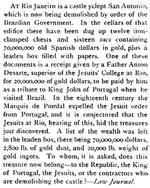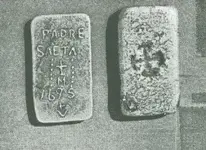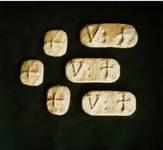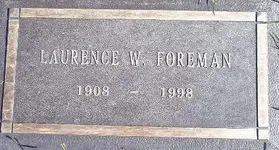Warning - extra coffee alert!
Hola amigos - this is another very long winded reply, feel free to just skip it, most of it is in response to Springfield, otherwise I ask your indulgence and thank you in advance.
Mike I see that you already posted an interesting reply while I was typing this - and I would only add that these treasures FOUND, are in my opinion fortunes, for some people this may not be a "fabulously rich" treasure, and in this aspect of how the treasure stories are PERCEIVED by the readers is one of the problems we have in our discussion. I would not turn up my nose at a mere 82 pounds of gold, but for some people this is proof that all the treasure stories are "highly exaggerated" for the treasure would have to be far larger than this to qualify in their eyes .
Springfield wrote
OK, Oro, for the record, I acknowledge that you are a true believer in the Jesuit mines, and apparently in the 'vast hoards' of precious metals still hidden all over AZ, and probably always will be.
I don't know why you
seem to see this in black and white, so to speak. I do not believe there are 'VAST" hoards of precious metals hidden "all over" Arizona. I do not know why the case has to be seen in that set of terms. The evidence, such as it is, points to some caches of bullion, more than a few candlesticks and crosses, possibly even tons of silver and hundreds of pounds of gold but not
so vast and certainly NOT hidden "all over Arizona" by any stretch of the imagination. In some cases the treasure was in reality of Franciscan origins, as at Bicuner, and there is evidence that this was already discovered and removed. To give an example of what size treasure the evidence supports
in my opinion, the massive silver altar and objects of San Xavier del Bac, was estimated at some $20,000 worth circa 1800, which today would be twenty times that value. To ME, that is quite a fortune, but hardly would class as a "vast hoard" on the scale of the Atocha treasure. For some folks, $400k is peanuts.
Springfield also wrote
I fear the numerous treasure magazine and newspaper adventure stories about AZ Jesuit treasure may have clouded your judgement.
That is certainly possible. More on this in a moment.
Springfield also wrote
As your McClintock memoir on the Vekol confirms, the rich outcrop the Indians showed Walker very quickly played out -one day - after the samples were removed. It wasn't a 'mine' than can be linked in any way to the Jesuits, except by speculation. One thing's for sure - Walker was shown a prospect, not a mine.
I have another report of this discovery, dating earlier in time than McClintock whom wrote his history from memory, which includes the fact that there was a large pile of the silver ore already extracted on the site of the vein. This pile of already mined out ore had to result from
mining activity. Did you also note that the ore McClintock mentioned was very rich? The original vein played out quickly but further development found much more silver in the hill, hence the many tunnels and shafts dug.
Springfield also wrote
The Wandering Jew was obviously just a prospect that showed only galena and a little copper, and was quit on by the brothers.
I have another source which states the Wandering Jew was found with a sizable trench already dug in the vein, and already very old, showing that the padres had been mining it. Not "just a prospect".
Springfield also wrote
This is all the evidence you've presented so far. There may be other Jesuit mines in the area - maybe some are 'fabulously rich' - but, other than in the mostly-manufactured treasure legends, we can't comment because we don't know where they are. Modern AZ mining districts were able to prosper on the bones of the known earlier Jesuit workings - why not the 'fabulously rich, still-hidden' ones? The legends are impressive - but what about their provenance?
Provenance - for mines which were being operated illicitly. Do you see a problem in that mindset? Do drug smugglers keep paper records of their shipments and who receives them? Even your phrase there, "fabulously rich" is a highly subjective term - for some prospectors, finding a vein with over 20 ounces of silver per ton, would be fabulously rich, for others, this would not even be worth their time to dig it out. So it is quite possible that some or all of the mines worked by padres and Spaniards for that matter, may not amount to "fabulously rich" in your opinion, while to another person it would be. Early treasure hunters DO mention that such incriminating records of illicit mines DID exist at one time, found at old missions and almost certainly removed by the early treasure hunters or possibly simply sold by Franciscan padres of the late 19th century when they were desperate for funds.
Springfield also wrote
To satisfy your curiosity: I would be surprised if you claimed the 'earth rotates', because so far, your stance seems to be, 'the sun moves back and forth'.
Then perhaps the problem is not at this end. I thought the case, presented over several years time now, was not so confusing and contrary as saying the sun moves back and forth.
Springfield also wrote
I can certainly identify with your enthusiasm, as I also suffer from the treasure disease. It ate me up for decades. I guess the difference between us is that I prefer to be standing on firmer ground before I go all in.
This brings us to what may well be the root of the difficulties in our discussion. I am fully aware that the scientific approach to the question is to assume everything is false, until proven true. The most successful treasure hunters have followed a similar, but polar opposite approach, that
it is true until proven false. In the case of Jesuit treasures/mines, if it is true that they never had any,
then there should not be ANY evidence that there were. This is not the case for there is evidence, despite the modern revisionist historians efforts to whitewash the mission system and period of history. The fact that there is evidence that the padres (and I include the Franciscans and even one Augustinian in AZ, or Franciscans entirely in NM and California)
were involved in mining, yet we have virtually no record that they shipped the products of the mining out legally, is the basis for hunting the caches.
Your caution and skepticism are wise and even healthy, some treasure hunters have gone nutty in a belief in some fantasy treasure, and it would be a waste of time to search for a non-existant mine or treasure. On the other hand, we can not expect to have full records of production and exact maps showing how to get to the mines and hidden cache(s) either. Over two centuries have lapsed since the mines of Pimeria Alta were abandoned, some likely concealed by the same Indians that had worked in them making the search for them very difficult. We have only relatively little info, sketchy as some would describe it, and if this is not enough for you to expend your time and treasure in a search, that is your decision. You stand a far better chance of making interest on putting your money in a savings account than in spending it searching for a lost treasure. Chasing down "legends" is after all not a sure way to riches, but for many treasure hunters it is not all about the money anyway. Even Mel Fisher, having found the Atocha and securing wealth, did not then quit searching for yet more.
As to my own judgement being clouded, from reading treasure stories, this is indeed possible; what has tipped the scales in my mind however has been what I have seen with my own eyes, on the ground or to be more accurate, in the ground. It is also possible that your judgement has been clouded in the opposite direction, making you doubt ALL treasure stories, from having not made a discovery or from finding some story (or stories) to be false and erroneous. Nothing will sour a person from being a treasure hunter faster than finding nothing, or that the source you trusted was nothing but a liar.
Good luck and good hunting Springfield, I won't bore you further on this topic as I do realize we have different philosophies about the very basis of this. I hope you and everyone reading this, find the treasures that you seek.
Roy









